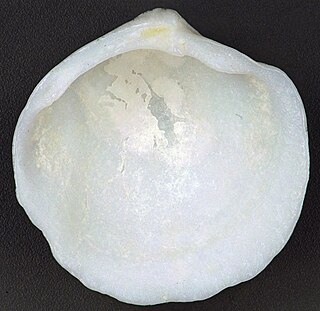
The shipworms are marine bivalve molluscs in the family Teredinidae: a group of saltwater clams with long, soft, naked bodies. They are notorious for boring into wood that is immersed in sea water, including such structures as wooden piers, docks and ships; they drill passages by means of a pair of very small shells borne at one end, with which they rasp their way through. Sometimes called "termites of the sea", they also are known as "Teredo worms" or simply Teredo, from the Greek τερηδώνteredōn, via Latin. Eventually biologists adopted the common name Teredo as the name for the best-known genus.

Bivalvia, in previous centuries referred to as the Lamellibranchiata and Pelecypoda, is a class of marine and freshwater molluscs that have laterally compressed bodies enclosed by a shell consisting of two hinged parts. Bivalves as a group have no head and they lack some usual molluscan organs like the radula and the odontophore. They include the clams, oysters, cockles, mussels, scallops, and numerous other families that live in saltwater, as well as a number of families that live in freshwater. The majority are filter feeders. The gills have evolved into ctenidia, specialised organs for feeding and breathing. Most bivalves bury themselves in sediment where they are relatively safe from predation. Others lie on the sea floor or attach themselves to rocks or other hard surfaces. Some bivalves, such as the scallops and file shells, can swim. The shipworms bore into wood, clay, or stone and live inside these substances.

The Unionidae are a family of freshwater mussels, the largest in the order Unionida, the bivalve molluscs sometimes known as river mussels, or simply as unionids.

Heterodonta is a taxonomic subclass of saltwater clams, marine bivalve molluscs. This subclass includes the edible clams, the cockles and the Venus clams.

Dosinia is a genus of saltwater clams, marine bivalve molluscs in the family Veneridae, subfamily Dosiniinae Deshayes, 1853. The shell of Dosinia species is disc-like in shape, usually white, and therefore is reminiscent of the shells of Lucinid bivalves.

Littoraria is a genus of sea snails, marine gastropod mollusks in the family Littorinidae, the winkles or periwinkles.

Lucinidae is a family of saltwater clams, marine bivalve molluscs.

Solemya velum, the Atlantic awning clam, is a species of marine bivalve mollusc in the family Solemyidae, the awning clams. This species is found along the eastern coast of North America, from Nova Scotia to Florida.

Lucina pensylvanica, commonly known as the Pennsylvania lucine, is a species of bivalve mollusc in the family Lucinidae. It can be found along the Atlantic coast of North America, ranging from North Carolina to the West Indies.

Anodontia alba, or the buttercup lucine, is a species of bivalve mollusc in the family Lucinidae. It can be found along the Atlantic coast of North America, its range extending from North Carolina in the United States to the West Indies.
Clathrolucina costata, or the costate lucine, is a species of bivalve mollusc in the family Lucinidae. It can be found along the Atlantic coast of North America, ranging from North Carolina to the West Indies.

Codakia orbicularis, or the tiger lucine, is a species of bivalve mollusc in the family Lucinidae. It can be found along the Atlantic coast of North America, ranging from Florida to the West Indies.

Ctena orbiculata, commonly known as the dwarf tiger lucine, is a species of bivalve mollusc in the family Lucinidae. It can be found along the Atlantic coast of North America, ranging from North Carolina to the West Indies.

Donax vittatus, or the banded wedge shell, is a species of bivalve mollusc in the order Cardiida. It is found on beaches in northwest Europe buried in the sand on the lower shore.

Glossus is a genus of mostly extinct marine bivalve molluscs in the family Glossidae. Only the oxheart clam, G. humanus, is still extant, living in flat, muddy regions deep off the North Atlantic coastline of Europe.
Enigmonia is a genus of saltwater clams, a marine bivalve mollusc in the family Anomiidae, the jingle shells. Enigmonia aenigmatica, the mangrove jingle shell clam, is the only species in this monotypic genus. It is found living on mangroves in the Indo-Pacific Ocean.

Codakia is a genus of saltwater clams, marine bivalve molluscs in the family Lucinidae.

Lucina is a genus of saltwater clams, marine bivalve molluscs.

Codakia distinguenda, the elegant lucine, is a species of marine bivalve mollusc. It was first described to science in 1872 by George Washington Tryon Jr.
Kuphus polythalamius is a species of shipworm, a marine bivalve mollusc in the family Teredinidae.
















